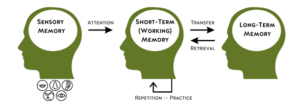
Learning is a complex task, and memory is a key piece of making learning stick. Understanding how memory works can help you design effective training. There are three types of memory: sensory, short-term and long-term memory.
Sensory memory filters everything you sense and perceive, in other words, whether you pay attention to the information or stimulus. For example, the color of a flower petal, the smell of coffee brewing or the taste of your dinner. If something grabs your attention, your brain moves it into short-term memory. If it doesn’t grab your attention, then that information passes right through.
The short-term, or working, memory is where information is held long enough to take action. Most things get tossed out after we’ve used them, e.g. an item on the grocery list, while other things will get transferred to long-term memory. If something gets into your short-term memory, it’s probably because it is significant to you. Short-term memory is limited—so limited, that you can only hold about 7 items (+/-2) in your working memory at a time! Working memory needs to be used and then cleared out, or that information needs to be practiced in order to move it to long-term memory.
Long-term Memory is the brain vault where information is stored. Long-term memory has almost limitless capacity! Every time you learn something new, connections are formed between neurons in the brain. These connections in your brain strengthen and reinforce when repeated or practiced, finally becoming so strong that information can be quickly and easily retrieved when needed.
But how does information move from working memory to long-term memory? The answer is through repetition and practice. Repetition doesn’t mean simply doing the same thing over and over and over, but applying that knowledge through practice, roleplay and problem solving. For effective learning to happen it takes about 40 repetitions to move new information into your brain vault.
Is there an efficient and effective way to do this? Yes! Consider your learning preferences—visual, auditory, kinesthetic, and read/write—and tailor your learning to include them. Another way to think about this and ensure that you are appealing to a variety of learning preferences is to present information through the following modes: Hear it, See it, Do it, Question it, Discuss it, Teach it.
Do you want to learn more? Reach out to the Colleague on Call team – we’ll help talk through solutions tailored to your needs.

